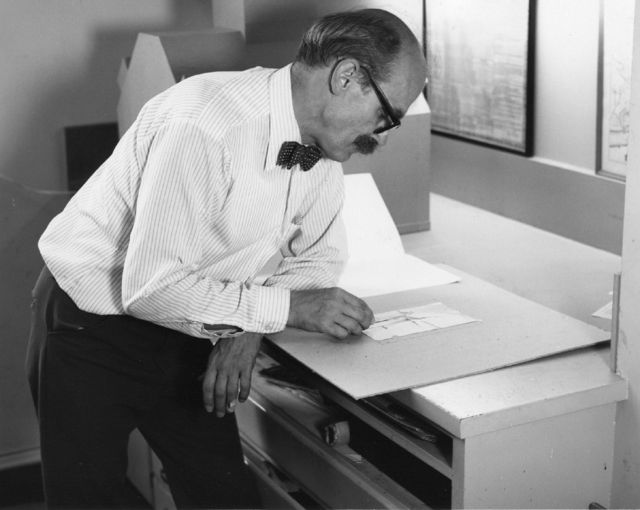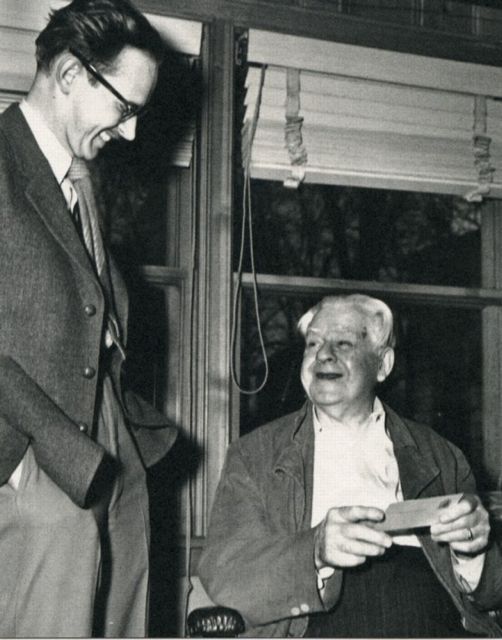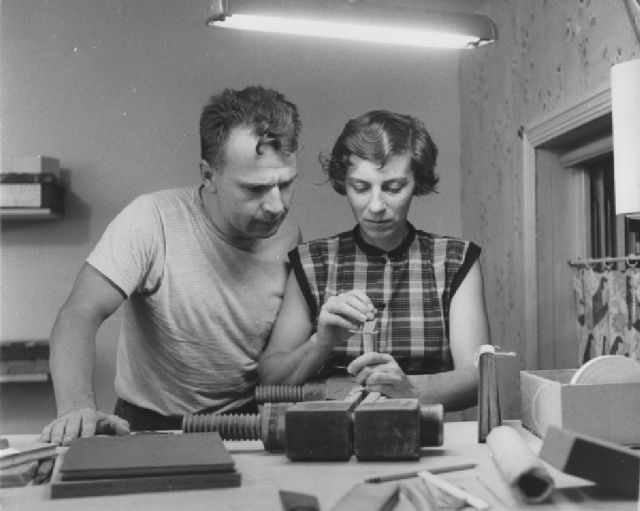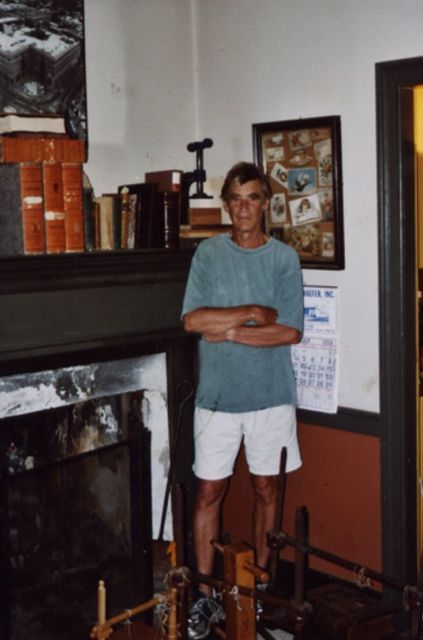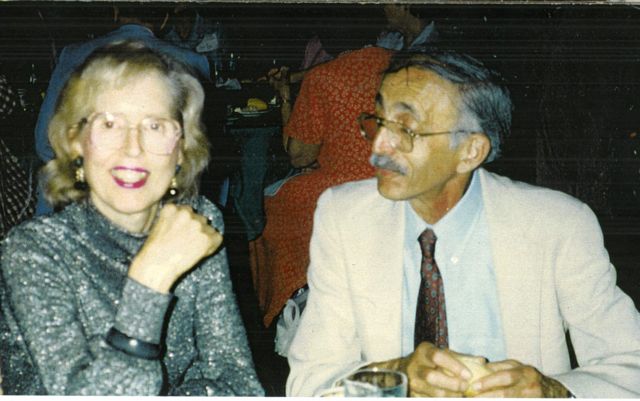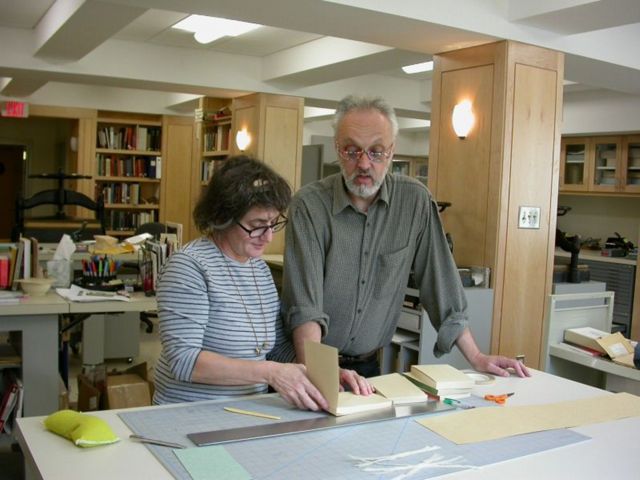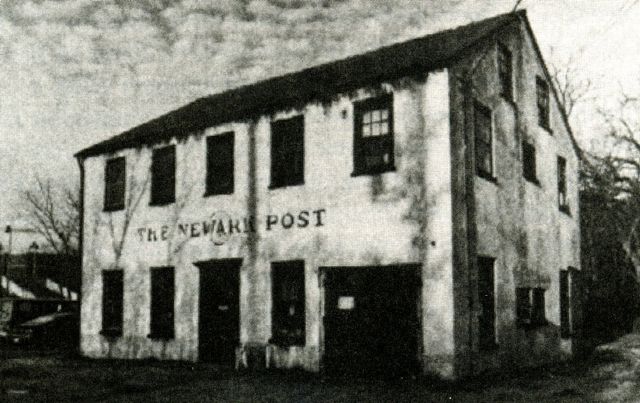From Three Rivers to the Delaware Bay
by Don Rash
This article is based on remarks presented at the 2006 Guild of Book Workers Standards of Excellence Seminar, celebrating the Guild's centennial, and is meant to represent the state of the Guild and the book arts at that time.
Don Rash and his late wife, Pam, studied bookbinding and calligraphy with Trudi and Fritz Eberhardt in the early 80s, then began working as independent bookbinders. After Pam's death in 1989, Don relocated to the Wyoming Valley of Northeastern Pennsylvania, where he established the Boss Dog Press in 2004. Since 2007 he has taught bookbinding under the rubric of The School for Formal Bookbinding. He produced edition bindings for the Press of Appletree Alley for 20 years; his design bindings have been exhibited internationally.
This survey is entitled “From Three Rivers to the Delaware Bay,” and I’d like to begin with two contemporaries at these two locations. In Pittsburgh, Rachel McMasters Miller, who had visited the Roycroft community at age nineteen in 1901, became enamored of the book arts. She studied bookbinding with Euphemia Bakewell, who herself had spent time at the Doves Bindery. Beginning in 1904, over the next seventeen years Miller proceeded to execute 126 full leather bindings. These were in the style of Cobden-Sanderson but they are not derivative; rather they show the work of a strong personality, and one not inclined to take the easy approach to a task. Miller participated in exhibitions every year from 1906 to 1921, including the Guild’s first, and also had two solo shows. Her final binding, uncompleted, was begun in 1920. From then on she concentrated on family and on the collection of botanical works that would become the nucleus of the Hunt Institute for Botanical Documentation, which she founded in 1960. She died in 1963.
At the same time that Rachel Miller was producing her bindings in Pittsburgh, Everett C. Johnson was publishing the Newark Post in Newark, Delaware (just a few miles from the Delaware Bay). Johnson had also made the pilgrimage to the Roycrofters and also returned imbued with the Arts and Craft spirit—so much so that he built a stone castle in the Roycroft manner to house his printing operation, which was dubbed “The Press of Kells.” The building is still in existence; when I was attending the University of Delaware in the early 1970s it housed the YMCA. Johnson also performed his civic duty first as state representative and later as secretary of state for the state of Delaware. The Press of Kells did a great deal of work for the then–Delaware College, much of it pro bono. The most significant work of the Press is the Memorial Book of Delawareans (ca. 1922), which includes the names of those Delawareans who died serving in World War I and still resides in Memorial Hall at the University of Delaware. Johnson’s health was always fragile; he died in 1926 at age forty-eight, one month after being elected to membership of the Grolier Club.
According to Willman Spawn (whom we will come to presently), Oldach and Company was a very successful commercial bindery in Philadelphia established by Frederick J. M. Oldach and run by Frederick and sons Herman, Fred Jr., Charles, George, and Albert. Albert, the artistic brother, left to open his own studio, where he taught classes. One of his students was Carolyn Rugh, who later became Carolyn Horton.
Carolyn Rugh studied in Europe before taking classes in Philadelphia with Albert Oldach. She began working at the American Philosophical Society (APS) in 1935, treating leather bindings at $1.00 an hour, with a work week of twenty-five hours. According to records at the APS, her contract was renewed every six months. She shortly expanded her work to include book restoration. In 1939 Carolyn Horton left Philadelphia for New Haven, Connecticut. She attempted to persuade the directors of the APS to allow her to continue to do their work, but they were insistent that it remain in-house.
Back in Pittsburgh, at the Carnegie Institute of Technology, Porter Garnett presided over the Laboratory Press from 1923 to 1935. Garnett was a theoretician rather than a practical printer, but he was an influential teacher. The Laboratory Press was closed from 1935 until 1958, when it was reconstituted, as we will see below, by Jack Stauffacher.
Thomas Patterson studied bookbinding and calligraphy at Carnegie Institute of Technology night classes in the 1920s; I suspect he felt the influence of Porter Garnett although I don’t know for sure. In the 1930s he was introduced to Mrs. Hunt, who provided him with commissions. When the Hunt Institute opened in 1961 he was appointed to the position of Master Bookbinder, which he held for eleven years. He was also Vice President at Large for the Guild of Book Workers from 1960–1965. He passed away in 1972.
In 1958 the eminent typographer Jack Stauffacher was appointed as an associate professor at the Carnegie Institute of Technology. He reestablished the Laboratory Press, and as A.M. Johnson said about Stauffacher in an article in Fine Print, “It was not without difficulty that Stauffacher reawakened the authorities at Carnegie Institute to the possibility of a fine teaching press.” During this period Hermann Zapf spent time at Carnegie Institute, and in 1961 was commissioned by Mrs. Hunt to design a house face for the Hunt Institute. The result was the Hunt Roman type.
I was very fortunate to be able to spend time with Willman Spawn while working on this talk. He has a wealth on information on people and places in the Philadelphia bookbinding community. Willman worked at the American Philosophical Society from 1947 until 1986, when he was appointed Honorary Curator of Bookbindings at Bryn Mawr College in the Philadelphia suburbs. During his tenure at the APS he did a tremendous amount of boxmaking, both of his own style of clamshell box and his own form of phase wrapper. He was also central to the rescue and restoration efforts resulting from the flooding of the College of Physicians library in the early 1970s. Finally, and not least, he is the acknowledged authority on American bookbindings, a result of decades of study and close examination of structure and decoration. He is currently cataloging the approximately 22,000 rubbings of bindings that he has made, and has traced a significant number of finishing tools of Philadelphia binders up to the yellow fever epidemics of the 1790s. And, he mounted the recent exhibit at Bryn Mawr and produced the catalog-- -all at the age of 86.
Dick Barnes was a professional photographer who, for whatever reason, decided to buy a small commercial bindery and set up shop. Together he and his wife ran the bindery for many years. During this time he took photographs of bookbinding subjects and compiled a large archive of Philadelphia binders and binderies. One of these subjects was John Bussinger, a professional edge gilder who was featured by Dick in his book Gilding and the Making of Gold Leaf. Note the size of the press in the photo.
This leads us to the W.O. Hickok Manufacturing Company of Harrisburg. The premier U.S. manufacturer of hand bookbinding equipment, the company is still in existence and is run by the fifth generation of the Hickok family. Established in 1844, the current plant was built in 1915. I was told by the current president, Peter Hickok, that the wood for their wooden equipment was brought into the plant and then aged for ten years before using it. Hickok developed the pen ruling machine that was the foundation of the business until the 1990s. The company still makes their number 00 1/2 standing press, as well as job backers and corner rounders, but the primary products today are drive systems for residential elevators.
David Godine referred to John Anderson as “probably the most underrated American typographer of the twentieth century.” This photo shows John Anderson with Fred Goudy. (I imagine Goudy saying, “All Bodoni is ultra-bad!”) Anderson lived in Maple Shade, New Jersey, for most of his career, and at various times worked either in Philadelphia or in his studio at home. Of importance here is that John mentored a number of people, including Claire Van Vliet and Ben Alterman.
Fritz and Trudi Eberhardt came to Philadelphia in 1954 at the request of Edwin Wolf of the Library Company to establish an in- house bindery. Fritz worked there until 1957 while Trudi did freelance work for the University of Pennsylvania. They later moved to Harleysville, where they set up their studio and worked for the next thirty years. During this time they did a variety of work: book restoration, calligraphy, design binding, edition binding. They also taught, with Trudi doing most of the teaching. Their roster of students over the years was small, but most went on to work seriously, whether as avocation or vocation. They include Dan Tucker and Claire Owen, proprietors of the Turtle Island Press—Dan Tucker later established the Ah Haa School and the American Academy of Bookbinding in Telluride, Colorado, and Claire Owen produces artists books and editions in Philadelphia; Jane Aaron; Jennifer Rosner, conservator at the Library Company of Pennsylvania; Bruce Bumbarger, conservator for the Haverford/Bryn Mawr Cooperative Bindery; Tony Haverstick; and Pam and Don Rash. Fritz passed away in 1997, Trudi in 2004.
Tony Haverstick was a philosophy professor in Lancaster who needed to repair his own books. His first instruction came from Dr. Francis J. Kafka, who taught bookbinding and graphic design at Millersville State College. Dr. Kafka published three books: How to Clothbind a Paperback Book, The Hand Decoration of Fabrics, and Linoleum Block Printing. He also introduced Tony to Fritz Eberhardt’s work in the early 1970’s. Tony spent time studying with Fritz before beginning his distinguished career as a book restorer.
For over three decades, Fred Shihadeh was The Bookbinder for clients on Philadelphia’s Main Line and beyond. He was working in Germany in 1960 when he decided on a change of career and apprenticed himself to a binder in Bremerhaven for a year. He also met and married his wife, Elke, there. They returned to the US in 1961 and Fred began to acquire equipment and take on restoration work. For several years thereafter Fred returned to Europe to study, taking workshops and attending courses at Ascona. Fred was, in Elke’s words, a “voracious collector,” to the point that he donated a very well equipped bindery to the Sugartown Historical Society from his duplicates. Fred also developed his own leather dressing, which he named Fredelka; it’s now known as Triple Crown. As if that weren’t enough, he kept bees and was a very good woodworker. Fred had a stroke in 1998, but continued working until 2003. He passed away in 2004. Elke is still continuing their work.
The Delaware Valley Bookworkers Association was established in the early 1980s, before the Guild created regional chapters. It sponsored a number of workshops during its existence, including a marbling workshop with Don Guyot and an endbanding workshop with Deborah Evetts. In 1983 the Association mounted an exhibition at Swarthmore College entitled “Book Arts in the Delaware Valley.” One of the exhibitors was Guild stalwart Margaret Johnson, who resided in Philadelphia until 1993. Margaret did work for the Pennsylvania Hospital Historic Library and the Library Company of Pennsylvania, and served as editor for the Guild Newsletter from 1983 to 1995.
Jean Gunner became bookbinder at the Hunt Botanical Institute in 1972, replacing Thomas Patterson. During her tenure, the Hunt mounted the major exhibition “The Tradition of Fine Bookbinding in the Twentieth Century.” She left the Hunt in 1986, at which time the decision was made to close the bindery.
Sid Neff is a lifelong fly fisherman and collector of angling books. His binding career grew out of the desire to repair the works in his collection. Aside froma few classes he is self-taught. His graphic design background led him to the artistic possibilities inherent in bookbinding. His work emphasizes the relationship between artifact and container, and makes distinctive use of Japanese paper onlays for image-making.
After twenty-three years in Chicago, Bill Minter moved to western Pennsylvania, where he continues to provide book and document conservation at the highest level as well as producing his ultrasonic welder for encapsulation. In September 2006 he encapsulated a thirty- foot 9/11 memorial poster for a fire company in the Bronx.
Jennifer Rosner became conservator at the Library Company in 1980 and thereafter studied with Fritz and Trudi Eberhardt, and with Frank Mowery at the Folger Shakespeare Library. She is currently assisted by Andrea Krupp.
Hedi Kyle came to Philadelphia in 1986 to become conservator of the American Philosophical Society, a position she held until 2002. She also began teaching at the nascent Book Arts program of the University of the Arts (UArts), which has since grown into the MFA in Book Arts and Printmaking. Hedi has taught and inspired several academic generations of artist bookmakers and helped to establish a growing book arts community in the rather staid Philadelphia book world.
One of Hedi’s students is Denise Carbone, who is the current conservator of the APS and a member of the first class of Book Arts MFA students at UArts. Not only does she oversee the conservation department, she takes interns, teaches at UArts, and until recently was chair of the Delaware Valley chapter of the Guild. She was also indispensable in the preparation of this history.
Acknowledgements
Many thanks to Denise Carbone, Jennifer Rosner, Willman Spawn, Bernadette Callery, Charlotte Tancin, Peter Hickok, Hedi Kyle, Elke Shihadeh, Sid Neff, Bill Minter, Tony Haverstick, Millersville State College, Bryn Mawr College.



